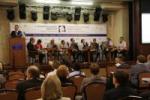- عربي
- Ukraine
- Economy
-
Investment
- Current Investment Trends
- Legal Conditions of Doing Business
- Investment Policy
- Competition
- Setting a Business in Ukraine
- Mergers and Acquisitions
- Taxation
- Import and Export
- Banks and Bank Regulation
- Convertibility and Profits Repatriation
- Currency Regulation
- Protection of Intellectual Property Rights
- Companies
- Travel to Ukraine
- About us
- Useful Sites
- Gallery
- News
Currency rates in UAH
| AED | ||
| BHD | ||
| EGP | ||
| KWD | ||
| LBP | ||
| OMR | ||
| QAR | ||
| SAR | ||
| SYP |
2015-07-06
| Kiev |  |
+32 |
| Donetsk |  |
+28 |
| Dnipropetrovsk |  |
+31 |
| Lviv |  |
+31 |
| Odessa |  |
+27 |
Historical Road to Ukrainian Constitution
In the princely Ukraine-Rus the initial written judicial laws were reformed on the basis of common law. The first recorded reference of the code of law Statut i Zakon Ruskyi (“Charter and the Laws of Rus”) contains the treaties with
In the 18th century, Pylyp Orlyk elected Hetman after the death of Ivan Mazepa wrote in a bright page in the history of the world constitutional endeavor. His treatise Pacty i Konstytutsii Zakoniv ta Volnostei Viyska Zaporizkoho (Pacts and Constitutions of Laws and Rights of the Zaporizia Army, 1710) is believed to be the first constitution of the Ukrainian state. It was based on the idea of natural law and the contractual origin of the state. The people of
Later on the motifs of justice, freedom, equality, and goodwill were sound in the documents of the Brotherhood of Saint Cyril and Methodius (1845 to 1847). It was Mykhailo Drahomanov and Mykhailo Hrushevsky who made the subsequent steps in creating political and legal conception of the balanced society.
These theoretical possessions of the Ukrainian liberation thought had played considerable role in the political processes that occurred in
On November 20, 1917, the Central Rada of
Almost simultaneously with the processes of revival of the Ukrainian state the territory that was part of the Russian Empire and another part of
During the military struggle of the Bolshevyks for the reestablishment of Soviet regime in
The principles of formation and the functioning of the structures of power proclaimed in the Soviet constitutions were predominantly of formal character. Elections at all levels happened as semi-compulsory voting for a candidate without an alternative appointed by the nomenclature Party organs. Deputies thus elected had, in fact, a single duty and it was to formally and in accordance with tradition unanimously approve decisions taken by the Communist Party. At the same time the Soviet constitutions granted the citizens extensive social rights for employment, education, health protection and pensions that were not only declared but affected actually. As to the political right – freedom of speech, press, assembly, movement, faith and secrecy of correspondence, were only declarative without being actually observed. Social and political activity existed under the exclusive leadership of the Communist Party and strict total control by the security organs (i.e., KGB). The Ukrainian Soviet constitutions operated for over seventy years.
The latest constitutional process in
Soon afterwards, outstanding historical events occurred: the Declaration of Independence of Ukraine of August 24, 1991, and nation-wide referendum of December 1, 1991, that verified the Act of Ukrainian Independence. During 1991 to 1996, commissions formed separately by the Verkhovna Rada and President put several drafts of the Constitution forward to be long-lastingly and they were discussed, amended and elaborated upon.
Thanks to the consensus reached among all the political forces of the country, and resulting by the Verkhovna Rada’s tense activity, on June 28, 1996, the Constitution of Ukraine currently in force and the Law to carry it into effect were adopted.



